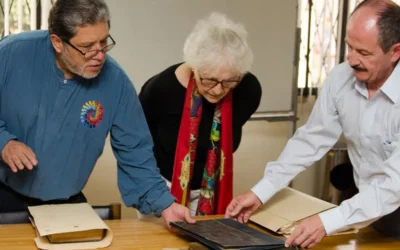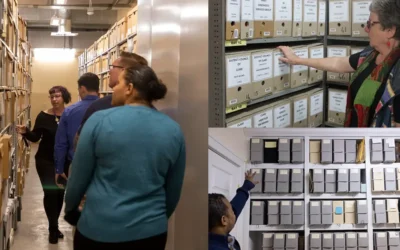The Importance of Archival Description
Margot Note
Researchers are demanding greater access to archival collections. At the same time, archives often reduce the level of processing. Can current descriptive standards and developments help solve this dilemma?
An inherent tension exists between providing access and describing archival holdings appropriately.
Finding aids and bibliographic records contain archival description for discovery, management, and understanding. Descriptions detail collection characteristics, content, and purpose. Describing archival materials require archivists to analyze, organize, and note details about the collections, such as creators, titles, dates, extent, and contents.
Although finding aids were created to describe content, they were not created to share information with a wider audience, especially those who use a cataloging database system. Basic archival principles can be brought into bibliographic description in several ways. Archivists recognize the importance of provenance in archival description. They understand that description should be at the group level since most archival material exists at this level. In addition, archival materials are preserved for reasons different from those for which they were created. They also require the flexibility of various levels of description.
Encoded Archival Description
EAD (Encoded Archival Description) was initiated in 1993 through the University of California’s Berkeley Finding Aid project. The goal was to create a standard for describing archives and manuscripts in a machine-readable format. By standardizing description, organizations such as the Research Library Group (RLG) can index the information and allow users to search the collections of repositories across the country.
Developing Encoded Archival Description (EAD) supplied a tool to help mitigate the geographic distribution of collections, which limited the ability of researchers to use primary sources. The goal of EAD is universal intellectual access. Researchers have always urged the off- and online publication of archival holdings to make their work easier. Descriptive coding involves designating what each important component is. Making MARC a description markup system ensured that information could be exploited in multiple ways and made it possible to apply future uses unknown in the early stages of development. The success with MARC AMC, which described at the collection level, made it possible to make finding aids available through EADs.
The development of the format has led archivists to think more systematically about how archival work is conducted. Additionally, archivists realized the benefit of following standards, after a long tradition of using idiosyncratic descriptive practices.
The EAD’s DTD (document type definition) specifies the elements to describe a collection and the arrangement of those elements. DTD’s goals are naming and defining elements, naming and defining attributes, and deciding where and in what sequence elements should appear. The DTD structure could be used for new archival finding aids and existing finding aids. The elements were repeatable to mimic the hierarchical structure of finding aids.
Authority Information
Provenance can be used as a basis of access and retrieval and not just as an underlying concept for arrangement. Provenance information—information about the records creators—can be used as authority information.
Archivists must be able to separate information about records creators from information about the records themselves. There is a benefit to building the authority information into the system instead of having separate authority files, as generally exist in libraries. Again, this makes even more sense in an era when a smaller percentage of an institution’s users come to the repository.
Function plays a role in arrangement and description in terms of access. Functions exist but are not always carried out by the same agency over time. A need exists to track that function, whether the name of the office or its place in the larger organization changes.
The fluidity of function leads to the notion that one series could belong to several records groups over time. Again, there is a hierarchy for the organization but not for the records.
Change and Continuity
Archival description encompasses the dual processes of cataloging and production of finding aids. The complexities of modern organizations and the detachment of description (especially online) from the actual materials have complicated descriptive practices for archivists.
Margot Note
Margot Note, archivist, consultant, and Lucidea Press author is a regular blogger and popular webinar presenter for Lucidea, provider of ArchivEra, archival collections management software for today’s challenges and tomorrow’s opportunities. Read more of Margot’s posts here.
Similar Posts
Enhancing Collaboration; Methods for Archivists
Archivists can enhance collaboration through user-centric approaches and efficient processing methods based on customer service principles.
Navigating Selection in Archival Practice
The archival selection process is far from straightforward, given the limitations of long-term preservation and ongoing accessibility challenges.
Responsible Stewardship in Archival Practice
Responsible stewardship is a philosophy that guides the actions and decisions of archivists in safeguarding collective memory.
A Modern View of a City’s History via ArchivEra
Brief success story on City of Regina Archives’ use of ArchivEra to manage collections of legal, historical, administrative or financial significance
Hosting service
Enjoy all of the benefits of your Lucidea solution with secure, reliable, stress free hosting
Programs & incentives
No matter your size or budget, we’ve got you covered, today and tomorrow




Leave a Comment
Comments are reviewed and must adhere to our comments policy.
0 Comments